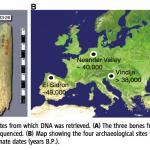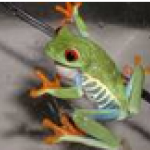Neanderthal
Years ago I proposed a theory (not anywhere in print, just in seminars and talks) that went roughly like this. Humans hunt. Dogs hunt. Prey animals get hunted. Each species (or set of species) has a number of characteristics such as the ability to stalk, track, kill, run away, form herds, etc. Now imagine a landscape with humans, wolves, and game animals all carrying out these behaviors, facilitated with various physical traits. Then, go back to the drawing board and redesign the system.
The hunting abilities of humans and dogs, the tendency of game animals to herd up or take other…
We had a great discussion with John Hawks on the radio today. The podcast of that conversation is available via any one of the routes indicated here.
We discussed australopiths, Homo, Paleolithic sex, ancient DNA and fossil casting calls. And more. Check it out.
Thanks, John, for your time!
Check out this video my friend Lynn made:
More here, including lots of text. Teachers, you could probably find a use for this in your classroom.
This week, Science published two papers about the genetics of Neandertals from a team of scientists based at the Max Planck Institute of Evolutionary Anthropology. The first (which is the only one anyone seems to really care about) gives a draft version of the entire Neandertal genome - a whopping 4 billion base pairs of DNA. They use this information to look for genomic regions that may have been affected by positive selection in ancestral modern humans that led to their separation from Neandertals, and found some very interesting ones that include genes involved in metabolism and in…
The complete genome of a Neanderthal dating to about 38,000 years ago has been sequenced by the team lead by Svante Paabo. The genome will be announced on Darwin's Birthay, Feb 12.
"We are working like crazy at the moment," says Pääbo, adding that his Max Planck colleague, computational biologist Richard Green, is coordinating the analysis of the genome's 3 billion base pairs.
Comparisons with the human genome may uncover evidence of interbreeding between Neanderthals and humans, the genomes of which overlap by more than 99%. They certainly had enough time for fraternization -- Homo…
What was Neanderthal-Modern Human interaction really like? Fifty four teeth (some of which are fragments) and nine other bones dating to about 40-43,000 years ago represent the "most recent, and largest, sample of southern Iberian late Neanderthals currently known."
These and some closely related remains may indicate that these Middle Paleolithic holdouts were kissing cousins of nearby anatomically modern humans. Or maybe not.
We know that Neanderthals occupied all of Europe for over 125 thousand years during a period known (from the artifacts) as the "Middle Paleolithic." During…
Allen's Rule. One of those things you learn in graduate school along with Bergmann's Rule and Cope's Rule. It is all about body size. Cope's Rule ... which is a rule of thumb and not an absolute ... says that over time the species in a given lineage tend to be larger and larger. Bergmann's Rule says that mammals get larger in colder environments. Allen's Rule has mammals getting rounder in colder climates, by decreasing length of appendages such as limbs, tails and ears.
All three rules seem to be exemplified in human evolution. Modern humans tend to be larger and rounder in cooler…
Every few years a paper comes out "explaining" short stature in one or more Pygmy groups. Most of the time the new work ads new information and new ideas but fails to be convincing. This is the case with the recent PNAS paper by Migliano et al.
From the abstract:
Explanations for the evolution of human pygmies continue to be a matter of controversy, recently fueled by the disagreements surrounding the interpretation of the fossil hominin Homo floresiensis. Traditional hypotheses assume that the small body size of human pygmies is an adaptation to special challenges, such as…
Old man Dave writes to me about his back problems:
The spine. I want to know about the spine. I know you are not that kind of PHD but still……. I’ve had back problems most of my adult life. It seems to me if we were “intelligently” designed that we might have a more efficient, and less troubling, method of uprightedness…. given the way the spine is constucted isn’t it possible that we were not “made” to walk upright??
Well, the spine goes back a long time, Dave, long before you were busting yours trying to lift things with your back instead of your legs. (You know better, Dave!) There are…
It almost seems like there are two separate research project under way regarding the evolutionary history of Homo sapiens. One focuses on recent humans, tends to use DNA as a major source of information, and from this base projects back into the past. This approach tends to confirm the idea that humans share an African origin with a subsequent spread from Africa, with various degrees of complexity in that series of historical events. The other focuses on early human remains, sometimes including remains that would be placed by some in a separate species or sub species. This sort of…
Evolution: The Mind's Big Bang
I've known Shea for years ... since before grad school. Going out drinking with this guy was a little dangerous. Almost as dangerous as going out drinking with me.

Did humans wipe out the Pleistocene megafauna? This is a question that can be asked separately for each area of the world colonized by Homo sapiens. It is also a question that engenders sometimes heated debate. A new paper coming out in the Journal of Human Evolution concludes that many Pleistocene megafauna managed to go extinct by themselves, but that humans were not entirely uninvolved.
The paper by Pushkina and Raia ("Human influence on distribution and extinctions of the late Pleistocene Eurasian megafauna") examines sources in the literature and a number of databases for Eurasian…
Every few years a paper comes out "explaining" short stature in one or more Pygmy groups. Most of the time the new work ads new information and new ideas but fails to be convincing. This is the case with the recent PNAS paper by Migliano et al.
From the abstract:
Explanations for the evolution of human pygmies continue to be a matter of controversy, recently fueled by the disagreements surrounding the interpretation of the fossil hominin Homo floresiensis. Traditional hypotheses assume that the small body size of human pygmies is an adaptation to special challenges, such as…
You can now read the Krause et al (2007) paper from Current Biology regarding the FOXP2 variant found in Neanderthals in an open-access on-line form at Current Biology Online.
Here is the summary of the article:
Although many animals communicate vocally, no extant creature rivals modern humans in language ability. Therefore, knowing when and under what evolutionary pressures our capacity for language evolved is of great interest. Here, we find that our closest extinct relatives, the Neandertals, share with modern humans two evolutionary changes in FOXP2, a gene that has been implicated in…



